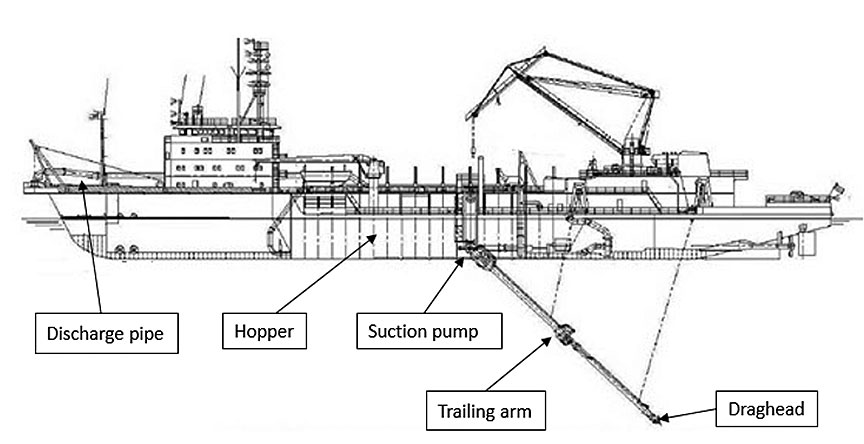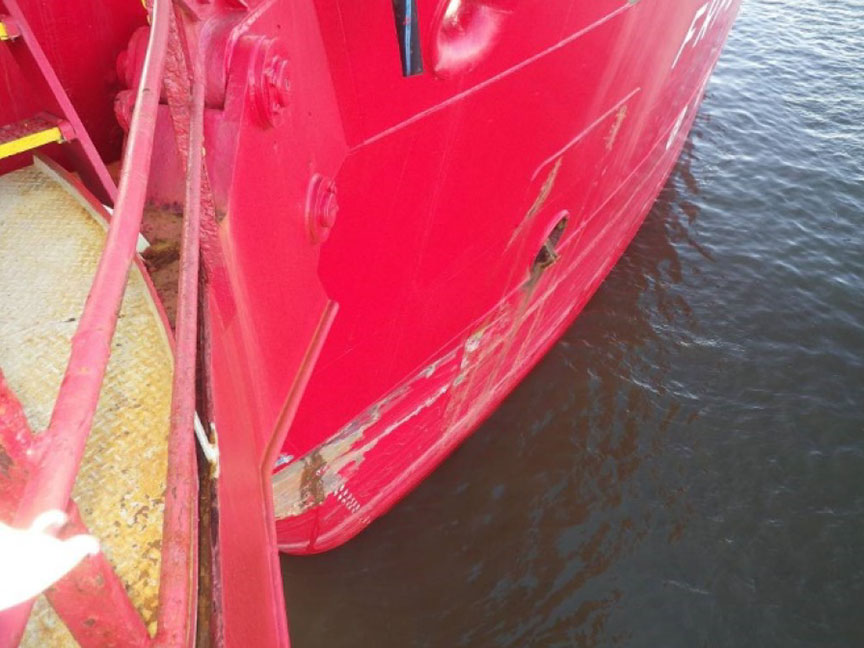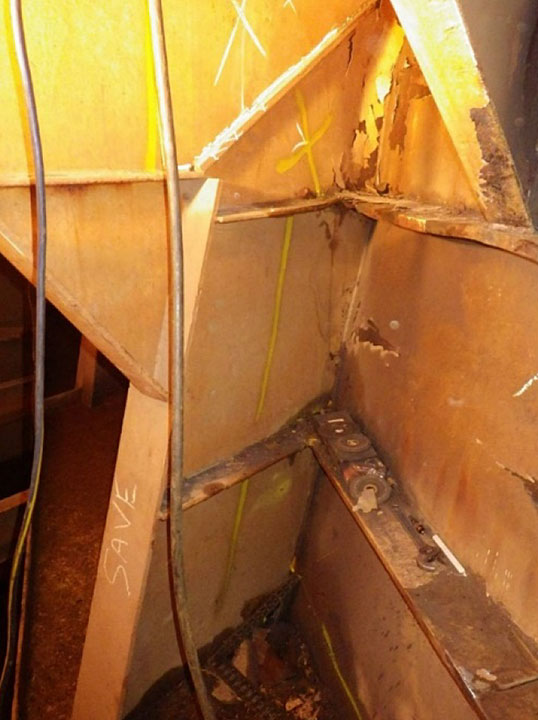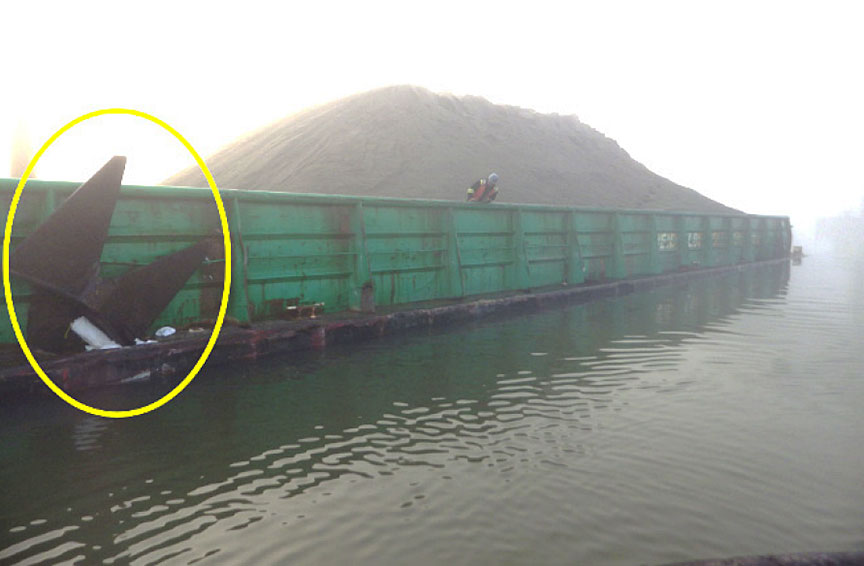Collision
Dredger FRPD 309
Fraser River, British Columbia
The Transportation Safety Board of Canada (TSB) investigated this occurrence for the purpose of advancing transportation safety. It is not the function of the Board to assign fault or determine civil or criminal liability. This report is not created for use in the context of legal, disciplinary or other proceedings. See Ownership and use of content. Masculine pronouns and position titles may be used to signify all genders to comply with the Canadian Transportation Accident Investigation and Safety Board Act (S.C. 1989, c. 3).
The occurrence
On 04 December 2017, at 1908,Footnote 1 the dredger FRPD 309, owned by Fraser River Pile and Dredge (GP) Inc., departed a shipyard in Delta, BC, to begin dredging in the Fraser River. The vessel is a conventional trailing arm suction dredger, with the bridge and accommodation located forward and machinery space located aft (Figure 1). Prior to departure, the crew had carried out pre-departure checks, a safety meeting, and emergency drills.
After arriving at the designated dredging location, the vessel began dredging sand and sediment from the river bed into the hopper using the 2 trailing arms and a dredging pump. When the hopper was filled, the sand and sediment was pumped ashore via a pipeline. The master left the bridge at approximately 2100, handing over the command of the vessel to the officer of the watch (OOW). Two engineers, 2 deckhands, and a pipe operatorFootnote 2 were also on duty.
By 0347 on 05 December, the vessel had completed 2 discharges of the hopper and was dredging using 2 dragheads attached to the end of the trailing arms while stemming the river's current. The visibility was clear, with a rippled sea and light winds. By approximately 0420, the hopper was full again, so the pipe operator began to raise the dragheads using the winches. Shortly after the pipe operator confirmed that the dragheads were off the bottom, the OOW used both thrusters in conjunction with the engines to turn the vessel around to proceed to the discharge pipeline location.
Moments later, at 04:23:45, as the vessel was turning and the pipe operator was raising the trailing arms to the deck level, the vessel experienced a blackout.Footnote 3 Approximately 2 to 5 seconds elapsed before the power management system restored electrical power to the vessel. Because the power management system was in semi-automatic mode,Footnote 4 the second engineer was able to quickly start the third generator (port) and bring it online so that load could be increased to operational levels. Once power returned, the bridge team was able to quickly reset the electronic equipment that had tripped as a result of the blackout.
Approximately 2 minutes after the blackout, the OOW resumed the turn to port and the vessel continued towards the discharge pipeline location. However, at this time, the 2 engineers in the engine room were still resetting numerous alarms and both essential and non-essential circuit breakersFootnote 5 that had tripped, including some located in the fore part of the vessel, and they did not have enough time to restore the vessel to normal status before it resumed the voyage. During this time, the bridge team contacted the engine room to request resetting the shaft generators, hydraulic pumps, and the winches.
During the blackout, the control air compressor and service air compressor had tripped and had to be reset locally. Each compressor supplies air to an independent air receiver, which is maintained at a constant operating pressure and supplies compressed air to various machinery.
The control air receiver, which supplies compressed air to keep the main engine clutches engaged, is maintained at 7.5 bar. The system is fitted with 2 alarms: a low pressure alarm (which activates at 6 bar) and a failure alarm (which activates at 5 bar). At some point following the blackout, both the low pressure and the failure alarms for the control air receiver activated. However, these alarms went unnoticed by the engineers, who continued to be occupied with resetting tripped breakers and alarms.
At 0430:45, the vessel was proceeding to the discharge pipeline location at a speed of approximately 7.2 knots when propulsion was lost; the main engine clutches had automatically become disengaged after the control air pressure fell below 5 bar. The loss of propulsion alarm activated on the bridge and in the engine room. As well, on the bridge, the indicators for the shaft generators and the propeller pitch went to zero.Footnote 6 One of the thrusters, which was powered by the shaft generators, also became unavailable. The OOW attempted to clutch in the propulsion, but there was no response. At 0431:48, the OOW called the master and informed him that the vessel had lost propulsion.
Meanwhile, the FRPD 309 continued proceeding ahead under its own momentum and was now on a collision course with the tug Storm Wave, which was towing the loaded barge Evco 60 in the vicinity. The OOW on the FRPD 309 applied the rudder to starboard in an attempt to steer the dredger away from the tug and tow. At 0431:58, the OOW notified the Storm Wave that the FRPD 309 had lost propulsion and requested that the tug keep out of the way. At 0432:14, the general alarm was sounded, and the deckhand on the bridge was instructed to go forward and let go the anchor.
Moments later, the OOW made an announcement on the PA system warning the crew of the imminent collision. Because the main engines were still running, the engineers were not aware of the propulsion failure until the general alarm was sounded and the OOW made the announcement. One of the engineers had restarted both air compressors, but this was done too late to prevent the main engine clutches from disengaging. At 0432:54, the dredger collided with the Evco 60 while making way at approximately 4.5 knots.
The OOW reported the collision to Marine Communications and Traffic Services and informed the master, who arrived on the bridge shortly afterwards. The vessel then anchored and communicated with the Storm Wave, which continued on its voyage after assessing the damage to the barge. Approximately 1.5 hours later, the dredger weighed anchor after regaining propulsion. It then proceeded to the discharge pipeline location before returning to the shipyard for repairs at 0730.
At the time of the blackout, 2 of the 3 diesel generators (starboard and inboard) were in operation. The vessel's power management system had preferential tripping: in an overload situation, this will automatically disconnect non-essential loads from the switchboard, retaining power to essential equipment. The investigation could not determine the cause of the blackout.
Damage
As a result of the collision, the FRPD 309 sustained damage to the shell plating (Figure 2) and forepeak tank forward of the collision bulkhead (Figure 3). Additionally, the port anchor was disconnected from its housing and became wedged in the Evco 60's hull. The Evco 60 also sustained structural damage due to the impact of the collision (Figure 4).
Safety action taken
Following the occurrence, the company
- revised the safety management system documentation related to emergency checklists and loss of propulsion;
- revised familiarization and training and briefed the crew on these changes;
- implemented training for all deck and engine room crew concerning safe parameters for air clutches and air telegraph;
- conducted emergency drills related to failure and maintenance of the control air systems; and
- fitted a control air compressor with auto-start capability.
In addition, the company is working on enhancing its training as well as developing a competency evaluation program.
Safety messages
Recovery from a blackout
In this occurrence, once power was restored to the bridge following the blackout, the vessel resumed manoeuvring towards the discharge pipeline location almost immediately, without allowing the engine room crew time to reset all the alarms and breakers and verify the operational status of the vessel's systems and equipment. The bridge team did not confirm with the engine room that they had completed restoring the vessel's systems, nor did the engine room communicate to the bridge team that more time was needed to do so.
This occurrence highlights the importance of taking the time to ensure a vessel is fully restored to operational status following a blackout. Using comprehensive blackout recovery checklists and conducting meaningful drills are tools that can help make a crew's response to a blackout more effective.
This concludes the TSB's limited-scope investigation into this occurrence. The Board authorized the release of this investigation report on . It was officially released on .



